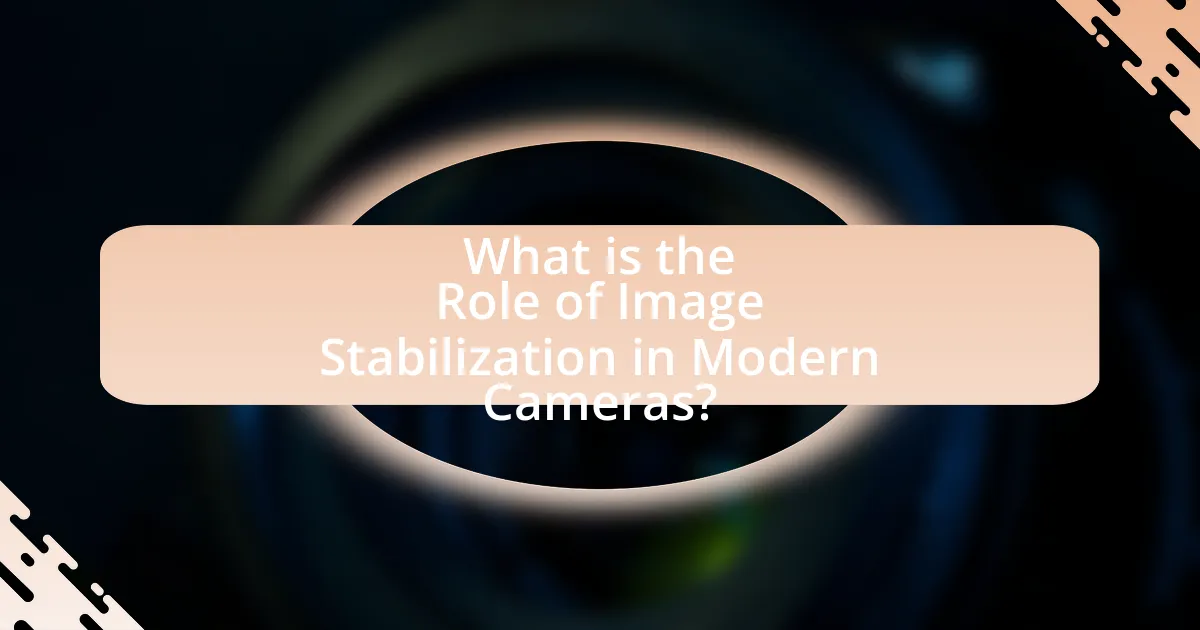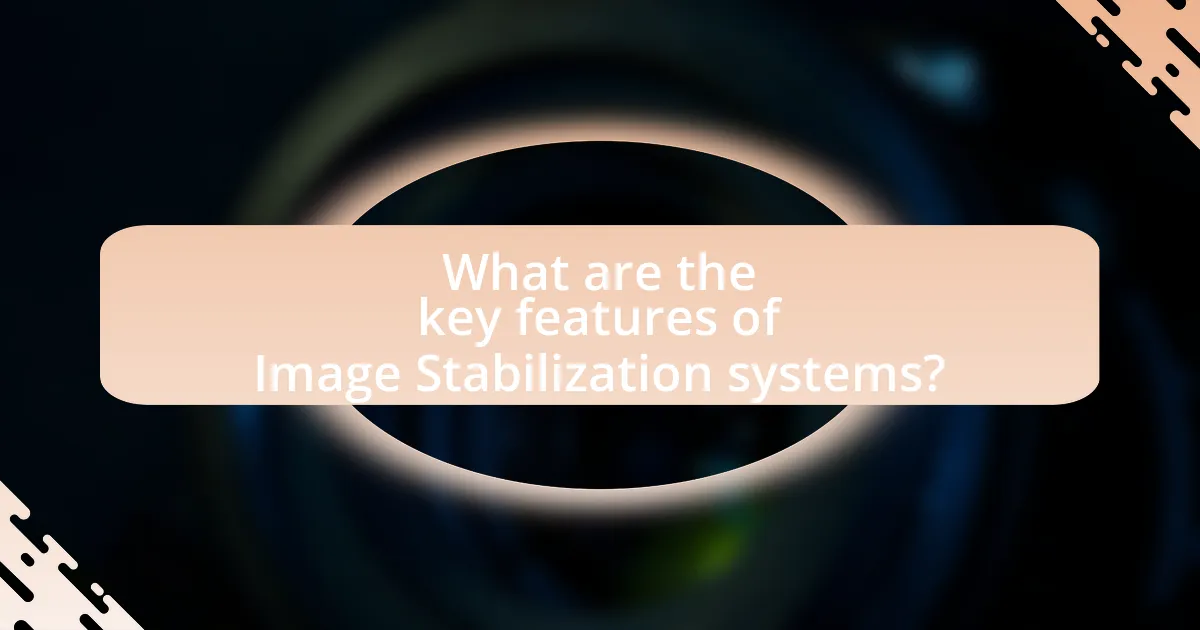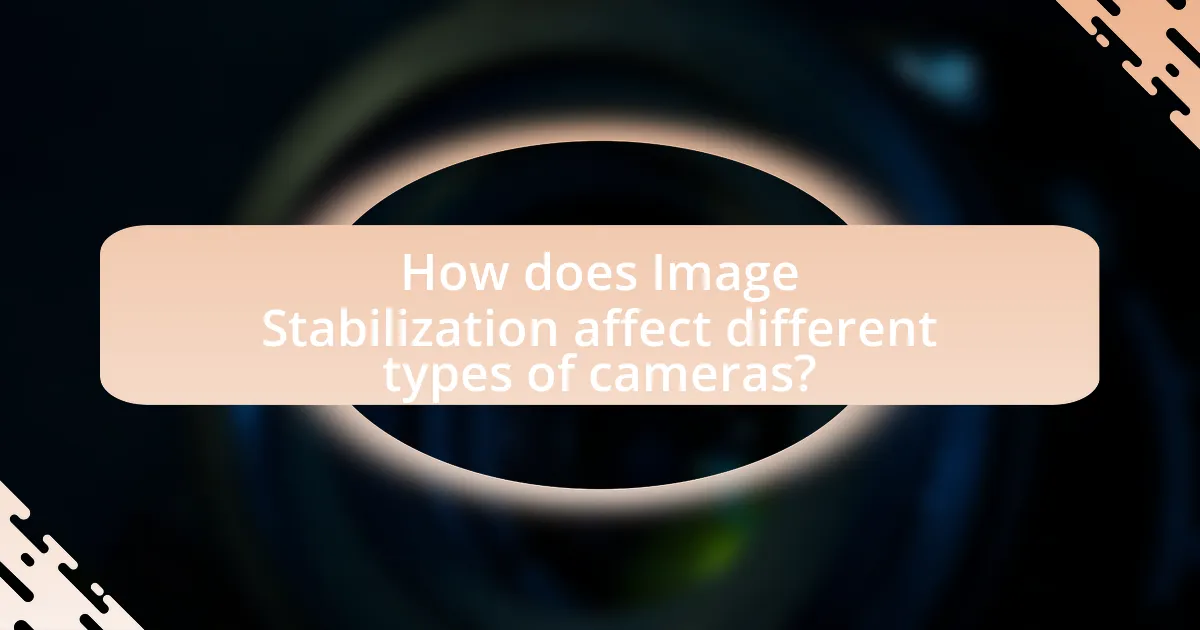Image stabilization is a crucial technology in modern cameras that significantly reduces blurriness caused by camera shake during handheld shooting, enhancing image clarity and video quality. The article explores various types of image stabilization, including Optical Image Stabilization (OIS), Electronic Image Stabilization (EIS), and Hybrid systems, detailing their performance, applications, and advantages. It also discusses the impact of image stabilization on different camera types, such as DSLRs and mirrorless cameras, and provides insights into how users can assess and effectively utilize these systems to improve their photography and videography outcomes.

What is the Role of Image Stabilization in Modern Cameras?
Image stabilization in modern cameras serves to reduce blurriness caused by camera shake during handheld shooting. This technology enhances image clarity by compensating for small, unintended movements, allowing for sharper images and smoother video footage. Studies show that optical image stabilization can improve low-light performance by enabling slower shutter speeds without sacrificing image quality, thus expanding creative possibilities for photographers and videographers.
How does Image Stabilization enhance photography and videography?
Image Stabilization enhances photography and videography by reducing blurriness caused by camera shake, resulting in sharper images and smoother videos. This technology compensates for small movements during shooting, which is particularly beneficial in low-light conditions or when using telephoto lenses. Studies show that cameras equipped with Optical Image Stabilization (OIS) can improve image clarity by up to four stops, allowing for slower shutter speeds without sacrificing quality. Additionally, Electronic Image Stabilization (EIS) can significantly enhance video footage by correcting motion artifacts, leading to a more professional and polished final product.
What are the different types of Image Stabilization technologies?
The different types of Image Stabilization technologies include Optical Image Stabilization (OIS), Electronic Image Stabilization (EIS), and Hybrid Image Stabilization. OIS utilizes physical adjustments of the camera lens or sensor to counteract motion, effectively reducing blurriness in images. EIS, on the other hand, employs software algorithms to analyze and correct motion in video footage, enhancing stability during recording. Hybrid Image Stabilization combines both OIS and EIS to provide superior stabilization by leveraging the strengths of each method. These technologies are critical in modern cameras, as they significantly improve image clarity and video quality, especially in dynamic shooting conditions.
How do these technologies differ in performance and application?
Image stabilization technologies differ significantly in performance and application, primarily between optical image stabilization (OIS) and electronic image stabilization (EIS). OIS utilizes physical adjustments of the camera lens or sensor to counteract motion, resulting in superior performance for still images and low-light conditions, as it maintains image quality without cropping. In contrast, EIS relies on software algorithms to analyze and correct motion, which can lead to a reduction in resolution due to cropping but is effective for video stabilization in dynamic environments. For instance, OIS is commonly found in high-end lenses and smartphones, while EIS is prevalent in action cameras and mobile devices, where compactness and versatility are prioritized.
Why is Image Stabilization important for modern camera users?
Image stabilization is crucial for modern camera users because it significantly reduces blurriness caused by camera shake, enhancing image clarity and quality. This technology allows photographers and videographers to capture sharp images and smooth footage, even in challenging conditions such as low light or while in motion. Studies have shown that cameras equipped with image stabilization can improve the success rate of sharp images by up to 50% in dynamic environments, making it an essential feature for both amateur and professional users.
What challenges does Image Stabilization help to overcome?
Image Stabilization helps to overcome challenges related to camera shake and motion blur during photography and videography. By compensating for small, unintended movements of the camera, Image Stabilization allows for clearer images and smoother video footage, particularly in low-light conditions or when using telephoto lenses. Studies have shown that effective Image Stabilization can reduce the effects of camera shake by up to 90%, significantly enhancing the quality of captured images and videos.
How does Image Stabilization impact the quality of images and videos?
Image stabilization significantly enhances the quality of images and videos by reducing blurriness caused by camera shake. This technology compensates for small movements during shooting, resulting in clearer and sharper visuals. For instance, studies have shown that optical image stabilization can improve image clarity by up to 50% in low-light conditions, where camera shake is more pronounced. Additionally, video footage benefits from stabilization by providing smoother motion, which is crucial for professional filmmaking and content creation. The implementation of image stabilization systems, such as gyroscopic sensors and software algorithms, further validates its effectiveness in maintaining high-quality output across various shooting scenarios.

What are the key features of Image Stabilization systems?
Image stabilization systems primarily feature two main types: optical image stabilization (OIS) and electronic image stabilization (EIS). OIS utilizes physical adjustments of the camera lens or sensor to counteract motion, effectively reducing blurriness caused by hand movements. EIS, on the other hand, employs software algorithms to analyze and correct image distortions in post-processing, enhancing video quality during motion.
Additionally, key features include the ability to stabilize both still images and video, real-time feedback for users, and compatibility with various camera types, including smartphones and DSLRs. These systems significantly improve image clarity and stability, particularly in low-light conditions or during fast-paced action, as evidenced by studies showing a reduction in motion blur by up to 90% in certain scenarios.
How do optical and digital stabilization methods compare?
Optical stabilization methods utilize physical components, such as moving lens elements or sensor shifts, to counteract camera shake, while digital stabilization relies on software algorithms to crop and adjust the image post-capture. Optical stabilization generally provides superior performance in real-time, especially in low-light conditions, as it directly mitigates motion during exposure, whereas digital stabilization can introduce artifacts and reduce image quality due to cropping. Studies indicate that optical stabilization can improve image sharpness by up to four stops compared to digital methods, which may only enhance stability without preserving full resolution.
What are the advantages and disadvantages of optical stabilization?
Optical stabilization offers significant advantages and disadvantages in modern cameras. The primary advantage is its ability to reduce blurriness caused by camera shake, particularly in low-light conditions or during handheld shooting, which enhances image clarity and sharpness. This is achieved through the use of moving lens elements or sensor shifts that counteract motion. A study by Canon in 2018 demonstrated that optical stabilization can improve image quality by up to 4 stops, allowing for slower shutter speeds without sacrificing sharpness.
Conversely, the main disadvantage of optical stabilization is the potential for increased cost and complexity in camera design. Systems that incorporate optical stabilization often require more intricate engineering and higher-quality components, which can lead to higher retail prices. Additionally, in certain scenarios, such as fast-moving subjects or panning shots, optical stabilization may introduce unwanted motion blur, negatively impacting the overall image quality.
In what scenarios is digital stabilization more effective?
Digital stabilization is more effective in scenarios involving handheld shooting, particularly in low-light conditions or when capturing fast-moving subjects. Handheld shooting often leads to camera shake, which digital stabilization can counteract by analyzing frames and adjusting the image accordingly. In low-light environments, where slower shutter speeds are necessary, digital stabilization helps maintain clarity by reducing motion blur. Additionally, when filming action scenes or sports, digital stabilization smooths out abrupt movements, resulting in more fluid footage. These scenarios demonstrate the capability of digital stabilization to enhance image quality by mitigating the effects of unwanted motion.
What role does sensor movement play in Image Stabilization?
Sensor movement plays a critical role in image stabilization by compensating for camera shake during exposure. This technology allows the sensor to shift in response to detected motion, effectively counteracting unwanted vibrations and resulting in clearer images. For instance, in systems like In-Body Image Stabilization (IBIS), the sensor can move along multiple axes to stabilize the captured image, which is particularly beneficial in low-light conditions or when using telephoto lenses. Studies have shown that cameras equipped with sensor-shift stabilization can reduce motion blur by up to four stops, enhancing overall image quality and allowing for sharper photographs in challenging shooting scenarios.
How does sensor-shift stabilization work?
Sensor-shift stabilization works by physically moving the camera’s image sensor to counteract motion and vibrations during photography or videography. This technology utilizes small actuators that adjust the position of the sensor in real-time, allowing it to shift in the opposite direction of detected movement. For instance, if the camera shakes slightly to the left, the sensor shifts to the right, effectively stabilizing the captured image. This method is particularly effective in reducing blurriness caused by hand movements, especially in low-light conditions or when using longer focal lengths. Studies have shown that sensor-shift stabilization can significantly improve image clarity, with some systems achieving up to 5 stops of stabilization, enhancing the overall quality of images taken in challenging conditions.
What are the limitations of sensor-based stabilization systems?
Sensor-based stabilization systems have several limitations, including their susceptibility to vibrations and external disturbances, which can compromise stabilization effectiveness. These systems rely on sensors to detect motion and adjust accordingly; however, rapid or extreme movements can overwhelm the system’s response time, leading to inadequate stabilization. Additionally, sensor-based systems may introduce latency, resulting in a delay between motion detection and stabilization adjustment, which can affect real-time performance. Furthermore, they often require complex algorithms and processing power, which can increase the cost and complexity of the camera system. Lastly, sensor-based stabilization may not be as effective in low-light conditions, where sensor performance can degrade, leading to less stable images.

How does Image Stabilization affect different types of cameras?
Image stabilization significantly enhances the performance of various types of cameras by reducing blurriness caused by camera shake. In DSLR and mirrorless cameras, optical image stabilization (OIS) is often implemented in the lens or sensor, allowing for clearer images during handheld shooting, especially in low-light conditions. For compact cameras and smartphones, electronic image stabilization (EIS) compensates for movement digitally, improving video quality and still images. Research indicates that cameras equipped with image stabilization can achieve up to four stops of improved exposure, allowing for sharper images without increasing ISO levels. This technology is crucial for videographers and photographers alike, as it enables smoother footage and clearer stills, particularly in dynamic environments.
What impact does Image Stabilization have on DSLR cameras?
Image Stabilization significantly enhances the performance of DSLR cameras by reducing the effects of camera shake, resulting in sharper images and smoother video footage. This technology compensates for small movements during handheld shooting, allowing photographers to capture clear images at slower shutter speeds without introducing motion blur. Studies have shown that cameras equipped with Image Stabilization can achieve up to four stops of improvement in low-light conditions, enabling better performance in challenging environments.
How does Image Stabilization enhance the performance of mirrorless cameras?
Image Stabilization enhances the performance of mirrorless cameras by reducing blurriness caused by camera shake during handheld shooting. This technology allows for clearer images and smoother video capture, particularly in low-light conditions or at slower shutter speeds. For instance, in-body stabilization systems can compensate for small movements, enabling photographers to achieve sharp images without the need for a tripod. Studies have shown that cameras equipped with effective stabilization can improve image sharpness by up to 4 stops, significantly benefiting both amateur and professional photographers.
What considerations should be made when choosing a camera with Image Stabilization?
When choosing a camera with Image Stabilization (IS), consider the type of stabilization system, such as optical or digital, as each has distinct advantages. Optical Image Stabilization (OIS) typically provides better performance for still images by compensating for camera shake through lens adjustments, while Digital Image Stabilization (DIS) can enhance video quality by cropping and stabilizing footage in post-processing. Additionally, evaluate the effectiveness of the IS system in various shooting conditions, including low light and fast motion, as some systems perform better in specific scenarios. The camera’s weight and ergonomics also play a crucial role, as a heavier camera may require more stabilization to counteract shake. Lastly, check for compatibility with lenses, as some cameras may only support IS with specific lenses, impacting overall performance.
How can users determine the effectiveness of Image Stabilization in a camera?
Users can determine the effectiveness of Image Stabilization (IS) in a camera by conducting practical tests that assess the stability of images captured during handheld shooting. One effective method is to compare images taken with and without IS activated, focusing on the sharpness and clarity of the subjects in both sets of images. Additionally, users can evaluate the performance of IS by shooting at slower shutter speeds, where the benefits of stabilization are more pronounced, and observing the reduction in motion blur. Research indicates that cameras with advanced IS systems can reduce shake by up to 5 stops, significantly improving image quality in challenging conditions.
What are some best practices for utilizing Image Stabilization effectively?
To utilize Image Stabilization effectively, ensure that you select the appropriate stabilization mode based on your shooting conditions. For instance, use optical stabilization for still photography and electronic stabilization for video to minimize motion blur and vibrations. Additionally, maintain a steady grip on the camera and use a tripod when possible, as this enhances the effectiveness of stabilization systems. Research indicates that using stabilization can reduce camera shake by up to 90%, significantly improving image quality in dynamic environments.